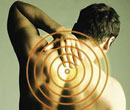A discogram, or discograpy, is a special diagnostic procedure that allows clinicians to examine spinal or neck structures in a very precise manner. Discrophy enables the physician to better identify an individual’s condition, determine specific problematic areas of the spinal column, and avoid invasive exploratory surgery. A special x-ray dye is injected directly into areas of the spine suspected to be damaged, creating a contrast effect. This effect allows for an enhanced x-ray picture of the spinal structures, which are nearly invisible when using standard diagnostic techniques. Candidates for this procedure include individuals who experience chronic pain, but have yet to be properly diagnosed.
Initially, patients will be given a local anesthetic to decrease the discomfort associated with the primary injection. Valium is also offered for sedation and relaxation. When the patient is comfortable, a thin needle is inserted into areas of the spine or neck considered problematic, damaged, or painful. A fluoroscopy machine is used during this process to assist the clinician with proper needle placement. When the physician is satisfied with the needle’s position, the special x-ray dye is injected. It is not uncommon for several dye injections to take place during the procedure, which ensures a thorough examination. Immediately afterwards, the patient will undergo a CT scan, which takes special x-ray photos of soft tissue and bone. The x-ray dye will provide a detailed image of the areas of discomfort, allowing for an accurate diagnosis and subsequent treatment plan.
Patients that take Valium should eat lightly and are required to have a friend or relative provide transportation. Patients should expect some soreness and irritation after the procedure, without any alleviation of pain. When the results of the diagnostic examination are reviewed, the physician will review treatment options with the patient.






